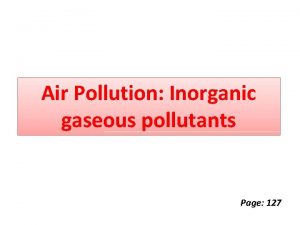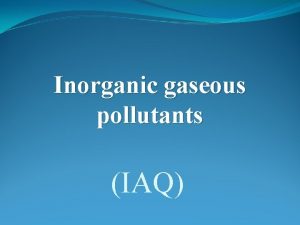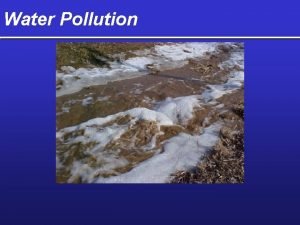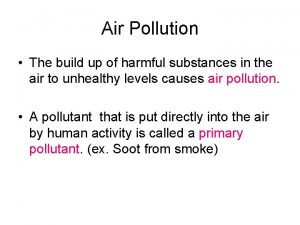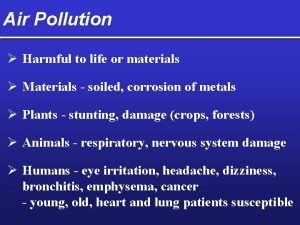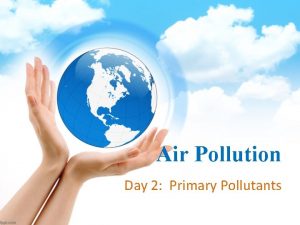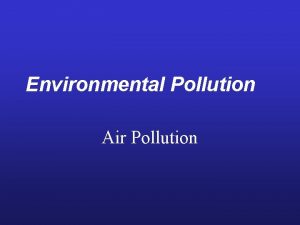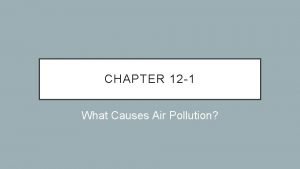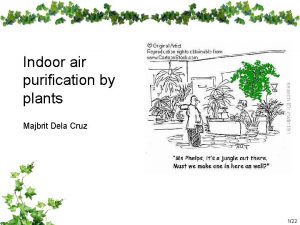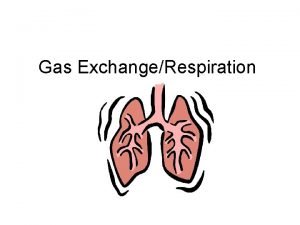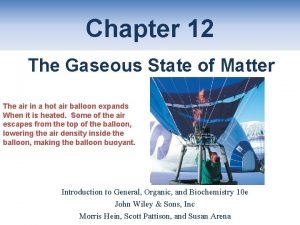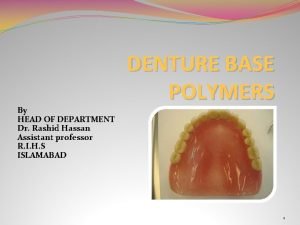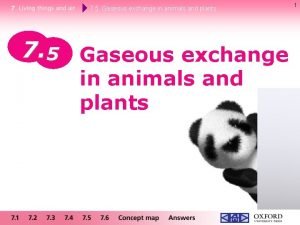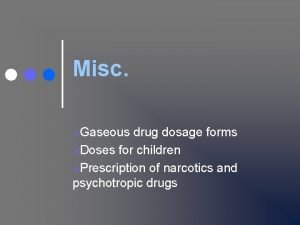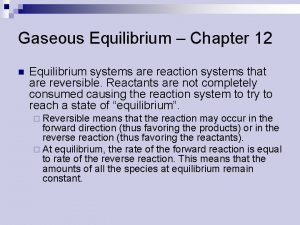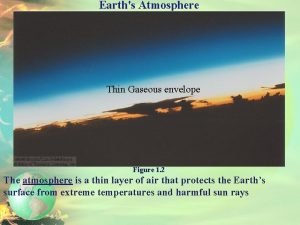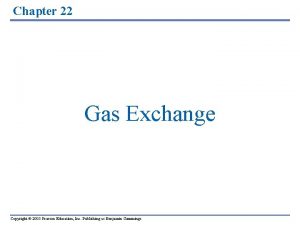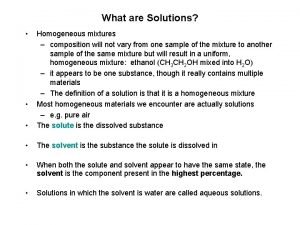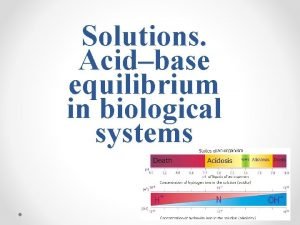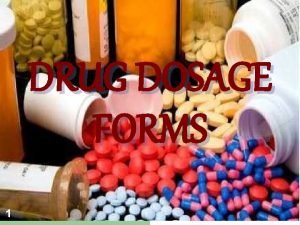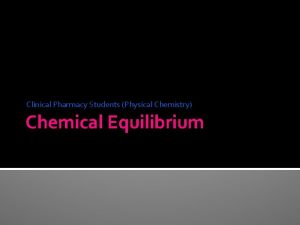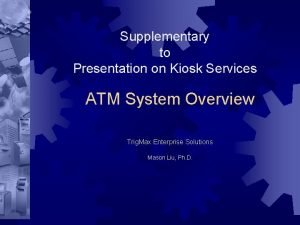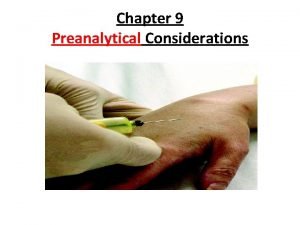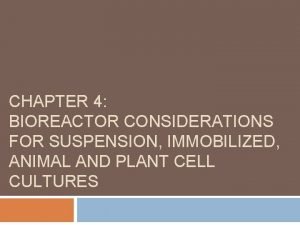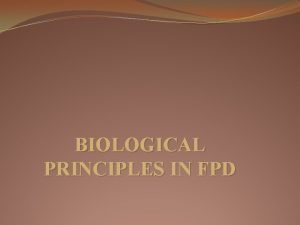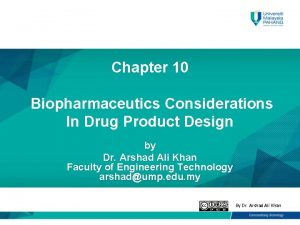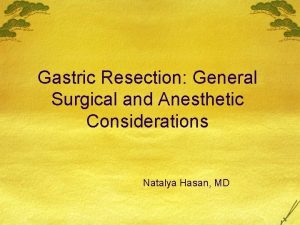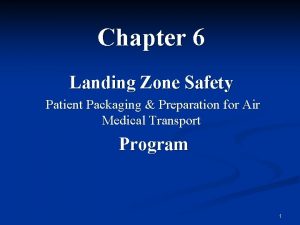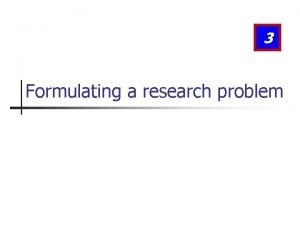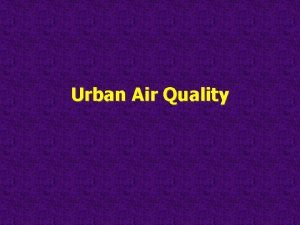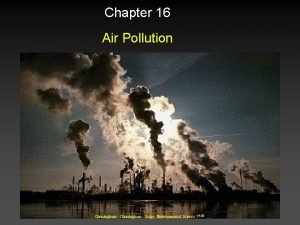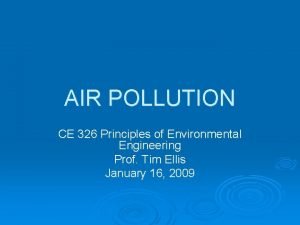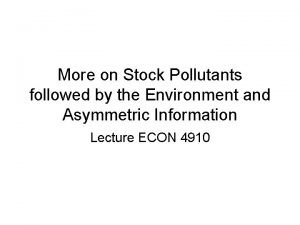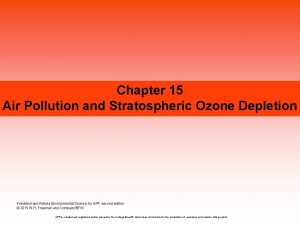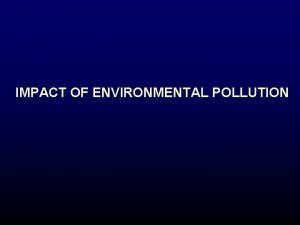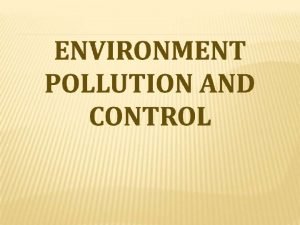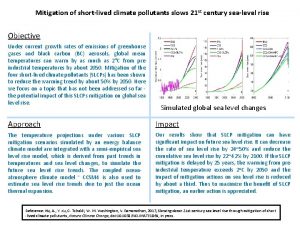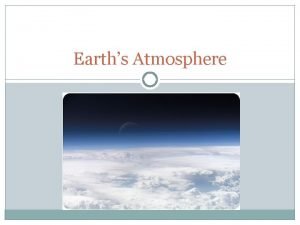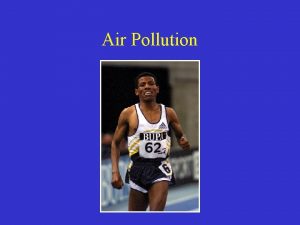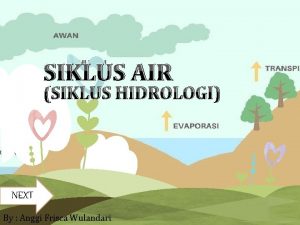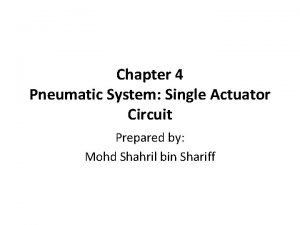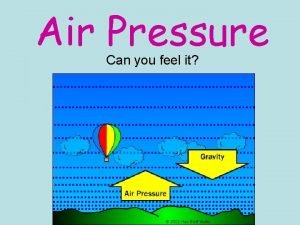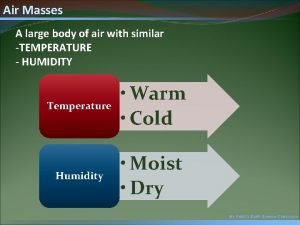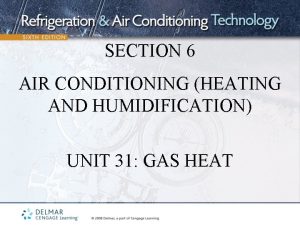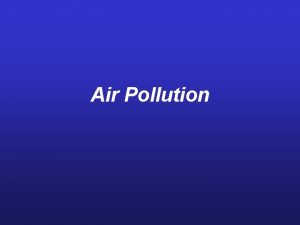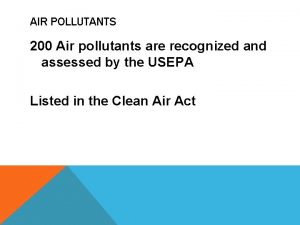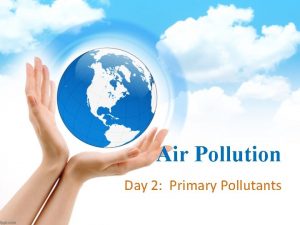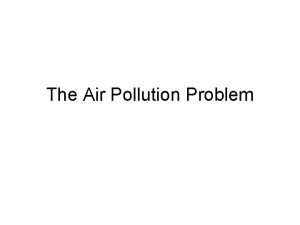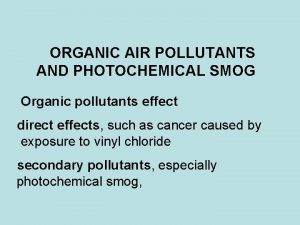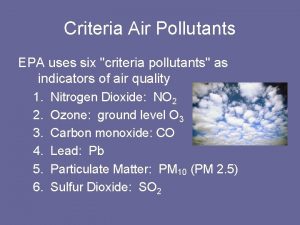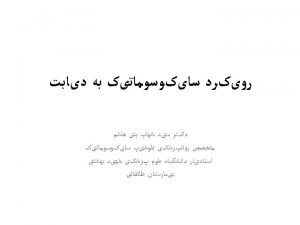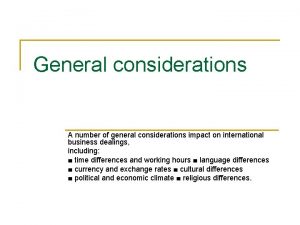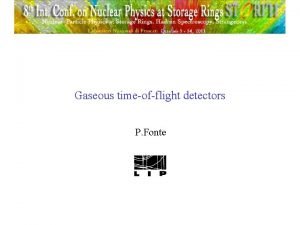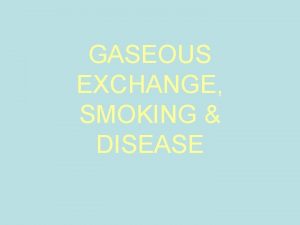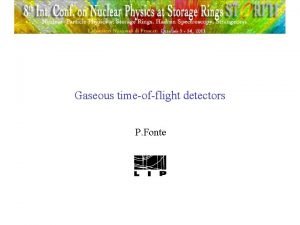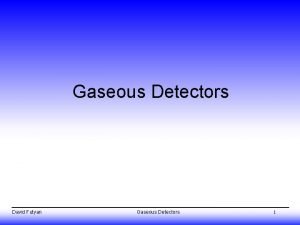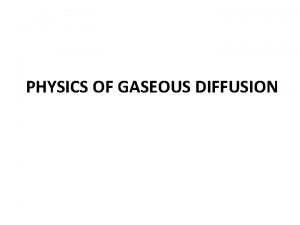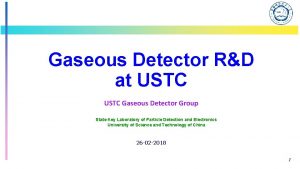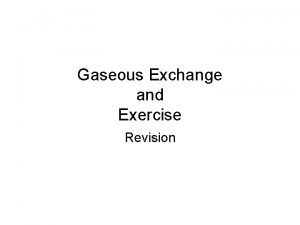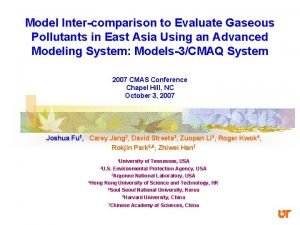Gaseous Pollutants General considerations on gaseous air pollutants



























































![Low-NOx Regime In a “low-NOx“ regime, the [VOC]/[NOx] ratio is high and the production Low-NOx Regime In a “low-NOx“ regime, the [VOC]/[NOx] ratio is high and the production](https://slidetodoc.com/presentation_image_h2/8348e6ac87845892f687a352ed46aa54/image-60.jpg)
![High-NOx Regime In a “high-NOx“ regime, the [VOC]/[NOx] ratio is low and the production High-NOx Regime In a “high-NOx“ regime, the [VOC]/[NOx] ratio is low and the production](https://slidetodoc.com/presentation_image_h2/8348e6ac87845892f687a352ed46aa54/image-61.jpg)



![The Weekend Effect • The change in the [VOC]/[NOx] ratio between week days and The Weekend Effect • The change in the [VOC]/[NOx] ratio between week days and](https://slidetodoc.com/presentation_image_h2/8348e6ac87845892f687a352ed46aa54/image-65.jpg)






















- Slides: 87

Gaseous Pollutants • • • General considerations on gaseous air pollutants Oxidizing power of the atmosphere and chemical reactivity Gas-phase chemistry of photochemical air pollution Emission control strategies Chemical kinetic mechanisms for air pollution modeling

Different Phases in the Atmosphere • Gases – Main gases (N 2, O 2) – Trace gases (pollutants) • Liquid water – Cloud and fog droplets – Rain drops • Solid water – Ice – Snow • Particles – Solid – Liquid

Types of Chemical Species • Molecules: for example, NO 2, O 3, etc. ; chemically stable species • Radicals: for example, OH, HO 2, NO 3, etc. ; very reactive species, very low concentrations • Atoms: for example, O(3 P), Hg 0; reactive or stable species, depending on their electronic state • Excited species: for example, O(1 D); highly reactive species, very low concentrations NO + HO 2 => NO 2 + OH molecule radical

Types of Chemical Species • Pollutants: adverse health and environmental effects • Precursors: chemical species that produce a pollutant via a chemical reaction • Oxidants: chemical species that oxidize other species NO + HO 2 => NO 2 + OH precursor oxidant pollutant

Ideal Gas Law Ideal gas law: PV=n. RT P (atm): Atmospheric pressure V (m 3): Volume of air T (K): Temperature R = 8. 31 J K-1 mole-1 = 8. 2 x 10 -5 atm m 3 K-1 mole-1: Ideal gas law constant n (moles): number of moles At P = 1 atm and T = 298 K (25 °C): n / V = 40. 9 moles / m 3 N = 6. 02 x 1023 molecules per mole ; 1 atm = 2. 46 x 1025 molec m-3

Unit Conversions 1 atm = 2. 46 x 1025 molecules m-3 = 40. 9 moles / m 3 At P = 1 atm: 1 ppb = 10 -9 atm = 2. 46 x 1010 molecules cm-3 (ppb: parts per billion) Conversion of mg/m 3 to ppb (MW is the molar weight of the chemical species in g/mole): 1 mg/m 3 = 1 O-6 / MW mole/m 3 = 1 O-6/ (40. 9 MW) atm = 103 / (40. 9 MW) ppb 1 ppb = (40. 9 MW) / 103 mg/m 3 For example, for ozone (MW = 48 g/mole): 1 ppb = 2 mg/m 3

Pollutant Categories • NOx: NO and NO 2 • NOy: all nitrogen oxides (except N 2 O), i. e. , NO 2, NO 3, HNO 2, N 2 O 5, organic nitrates • NOz: NOy - NOx • SOx: SO 2, SO 3, and H 2 SO 4 • VOC: volatile organic compounds, i. e. , alkanes, alkenes, aldehydes, alcohols, aromatic compounds, etc. • HC: hydrocarbons (organic compounds with C and H) • NMHC: non-methane hydrocarbons

Primary and Secondary Pollutants • Primary pollutants: they are emitted directly into the atmosphere – NO and NO 2 (NOx), SO 2, VOC (for example, HCHO, C 6 H 6), etc. • Secondary pollutants: they are formed in the atmosphere via chemical reactions – O 3 (formed from NOx and VOC), NO 2, HCHO, H 2 SO 4, HNO 3, etc.

Main Gaseous Pollutants • Sulfur dioxide (SO 2): Regulated air pollutant (respiratory health effects) and precursor of secondary particulate matter (PM) and sulfuric acid (contributor to acid rain) • Carbon monoxide (CO): Regulated air pollutant (anoxia) and precursor of ozone • Ozone (O 3): Regulated secondary pollutant (respiratory health effects) • Nitrogen oxides (NO and NO 2): Precursors of secondary PM, ozone, and nitric acid (contributor to acid rain), precursor of nitrogenous species contributing to eutrophication, NO 2 is a regulated air pollutant (respiratory health effects) • Volatile organic compounds (VOC): Precursors of secondary PM and ozone, some VOC are carcinogenic • Semi-volatile organic compounds (SVOC): Precursors of secondary PM • Ammonia (NH 3): Precursor of secondary PM

Urban Air Pollution Urban air pollution is due to gaseous and particulate (aerosols) air pollutants. Air pollution has adverse effects on health, atmospheric visibility, vegetation, and materials. Currently, emissions of SO 2 and CO from vehicles and industries are regulated in North America and Europe and the corresponding ambient concentrations have decreased considerably over the past decades. Today, the focus of urban air quality policies for gaseous air pollutants concerns mostly ozone (O 3) and nitrogen dioxide (NO 2).

Photochemical “Smog”: Smoke + fog Pollutants + solar radiation => photochemical pollution Photochemical smog: - Gaseous pollutants (ozone, nitrogen dioxide, formaldehyde, acroleine …) - Particles

Background Pollution Some pollutants have a lifetime of several days and can, therefore, be transported over long distances by the wind and thereby contribute to continental and regional background pollution. Urban pollution results not only from pollutant emissions from local sources but also from the long-range transport of pollutants from distant sources.

Importance of Atmospheric Ozone • Radiative properties in the stratosphere: Problem of the destruction of the stratospheric ozone layer • Air pollutant in the lower atmosphere (troposphere): adverse health effects (pulmonary irritant) and damage to vegetation • Greenhouse gas • Precursor of the hydroxyl radical, OH, which is the main oxidant in the atmosphere

Daytime Chemistry and Nighttime Chemistry • Daytime chemistry: – Photolysis => atoms and radicals => high reactivity of the atmosphere • Nighttime chemistry – No photolysis => few radicals => low reactivity of the atmosphere

Stratosphere and Troposphere • Stratosphere : – O 2 and O 3 absorb ultraviolet solar radiation (l < 290 nm) – Source of atomic oxygen to form O 3: O 2 + hn => O + O l < 242 nm • Troposphere – Solar radiation, which is effective for photolysis, is in the range: 290 nm < l < 730 nm; i. e. , there is no O 2 photolysis. – Source of atomic oxygen to form O 3: NO 2 + hn => NO + O 300 < l < 420 nm

Stratosphere and Troposphere Stratosphere Troposphere (< 15 km) Actinic flux as a function of wavelength at different altitudes in the atmosphere Source: De. More et al. , 1997, Publication 97 -4, Jet Propulsion Laboratory, Pasadena, California.

Oxidizing Power of the Atmosphere • Production of OH – Ozone photolysis leads to OH production: O 3 + hn (l < 310 nm) => O 2 + O(1 D) The excited oxygen atom becomes stable by reaction with a molecule: O(1 D) + M => O(3 P) + M O(1 D) + H 2 O => 2 OH

Oxidizing Power of the Atmosphere • The cleansing of the atmosphere occurs mostly via the oxidation of organic and inorganic chemical species – Organic species => CO 2 and H 2 O – Inorganic species => acids, nitrates, sulfates… • The three main oxidants are: OH, O 3, and NO 3 – OH: mostly during daytime (product of photolysis) – O 3: both during daytime and nighttime – NO 3: mostly at night (photolyzed during the day)

Chemical Lifetime of a Chemical Species • The lifetime indicates the chemical stability of the chemical species • For example, oxidation reaction of chemical species Xi by OH: Xi + OH => …, with k. OH(T) as the kinetic constant Destruction term: -k. OH [OH] [Xi], which leads to a characteristic time: tl, i = 1 / (k. OH [OH]) tl, i is also called the chemical lifetime or residence time. It should not be confused with the half-life, which corresponds to the time at which half of the reactant, Xi, has been consumed: t 1/2 = ln(2) / (k. OH [OH]) = 0. 7 tl, i

Lifetimes of some VOC in the Lower Troposphere

Lifetimes of some VOC in the Lower Troposphere Alkanes Anthropogenic alkenes Aldehydes Biogenic alkenes

Discovery of “Photochemical Smog” • Arie Haagen-Smit, a professor of biochemistry at the California Institute of Technology (Caltech), proposed and demonstrated in 1952 that air pollution in Los Angeles was due to reactions among nitrogen oxides (NOx) and volatile organic compounds (VOC) in the presence of solar radiation. Haagen-Smit, A. J. Chemistry and Physiology of Los Angeles Smog; Ind. Eng. Chem. 44, 1342 -1346, 1952.

Photochemical Smog: Ozone Formation NOx Nitrogen oxides: NO and NO 2 O 3 Ozone VOC Volatile organic compounds: alkanes, alkenes, aromatics, aldehydes, alcohols… Ozone is formed from nitrogen oxides and volatile organic compounds reacting in the presence of sunlight: It is a non-linear system

Oxidants of Photochemical Smog • Hydroxyl radical: OH • Ozone: O 3 + hn O(1 D) + H 2 O 2 + hn HNO 2 + hn => => NO 2 + hn O + O 2 => NO + O => O 3 NO 2 + O 3 => NO 3 + O 2 O(1 D) + O 2 2 OH NO + OH • Nitrate radical: NO 3

The Photostationary State Ozone formation: NO 2 + hv => NO + O 2 => O 3 NO + O 3 => Ozone destruction: The net chemical budget is zero NO 2 + O 2 O 3 This is also known as the Leighton cycle. NO NO 2

The Photostationary State NO 2 + hv => NO + O k 1 O + O 2 => O 3 k 2 NO + O 3 => k 3 NO 2 + O 2 Philip A. Leighton, Professor of chemistry at Stanford University, introduced the concept of a photostationry state among these three reactions: at equilibrium, all reaction rates are equal. This is the photostationary state of Leighton k 1 [NO 2] = k 2[O] [O 2] = k 3 [NO] [O 3]

The Photostationary State of Leighton NO 2 + hv => NO + O k 1 O + O 2 => O 3 k 2 NO + O 3 => k 3 NO 2 + O 2 At equilibrium (photostationary state), all reaction rates are equal: k 1 [NO 2] = k 2[O] [O 2] = k 3 [NO] [O 3] thus: [O 3] = (k 1 [NO 2]) / (k 3 [NO]) The ozone concentration produced by this reaction cycle is low.

Chain of Oxidation of Carbon Monoxide CO Propragation reactions Ozone formation CO + OH => CO 2 + H H + O 2 + M => HO 2 + M HO 2 + NO => OH + NO 2 _____________ CO + NO + O 2 => CO 2 + NO 2 + hv => NO + O 2 => O 3 _____________ NO 2 + O 2 => NO + O 3 Net budget NOx CO + 2 O 2 => CO 2 + O 3 Thus, the oxidation of one molecule of carbon monoxide leads to one additional ozone molecule

Chain of Oxidation of Carbon Monoxide (CO) Propagation reactions Ozone formation CO + OH => CO 2 + H H + O 2 + M => HO 2 + M HO 2 + NO => OH + NO 2 _____________ CO + NO + O 2 => CO 2 + NO 2 Hydroperoxyl radical NO 2 + hv => NO + O 2 => O 3 _____________ NO 2 + O 2 => NO + O 3 Net budget NOx CO + 2 O 2 => CO 2 + O 3 Thus, the oxidation of one molecule of carbon monoxide leads to one additional ozone molecule.

Ozone Formation Perturbation of the Photostationary Cycle Ozone formation NO 2 + hv O + O 2 => NO + O => O 3 (1) (2) Oxidation of NO to NO 2 with destruction of O 3 + NO => O 2+ NO 2 (3) Oxidation of NO to NO 2 without destruction of O 3 HO 2 + NO => OH + NO 2 Budget of reactions (1), (2) and (4) : HO 2 + O 2 => OH + O 3 (4)

Photochemical Smog The oxidation of CO perturbs the photostationary cycle by converting NO to NO 2 without O 3 destruction and leads to ozone formation O 3 NO NO 2 HO 2 OH CO 2 CO The oxidation of volatile organic compounds (VOC) leads to ozone formation in the same manner.

Volatile Organic Compounds (VOC) The main categories of VOC are the following: • Alkanes: hydrocarbons (C and H) with single C-C bonds • Alkenes: hydrocarbons (C and H) with one or more double C=C bonds • Aromatic compounds: a phenyl ring • Aldehydes: a carbonyl group (-HC=O) • Ketones: An oxo group (C=O) • Alcohols: C-OH • Ethers: C-O-C

Oxidation of VOC The oxidation pathways for VOC are the following: • Photolysis (mostly for aldehydes) • Reaction with OH • Reaction with NO 3 • Reaction with O 3 (for alkenes only) • Reaction with O(3 P) (negligible)

Oxidation of Formaldehyde (HCHO) HCHO + hv => H + HCO H + O 2 => HO 2 HCO + O 2 => HO 2 + CO ________________ HCHO + hv + 2 O 2 => 2 HO 2 + CO HCHO + hv => H 2 + CO HCHO + OH => HCO + H 2 O HCO + O 2 => HO 2 + CO __________________ HCHO + OH + O 2 => HO 2 + CO + H 2 O

Oxidation of Formaldehyde (HCHO) HCHO + hv => H + HCO H + O 2 => HO 2 HCO + O 2 => HO 2 + CO ________________ HCHO + hv + 2 O 2 => 2 HO 2 + CO HCHO + hv => H 2 + CO HCHO + OH => HCO + H 2 O HCO + O 2 => HO 2 + CO __________________ HCHO + OH + O 2 => HO 2 + CO + H 2 O Hydroperoxyl radical

Oxidation of Formaldehyde (HCHO) On average: HCHO + (hv, OH) + O 2 => HO 2 + CO + (1/2 H 2, H 2 O) NO + HO 2 => NO 2 + OH (+O 2) NO 2 + hv => NO + O 3 ________________ HCHO + (hv, OH) + 2 O 2 => O 3 + CO + (1/2 H 2, H 2 O) + OH Therefore, the oxidation of one molecule of formaldehyde leads to two additional molecules of ozone.

Oxidation of Acetaldehyde (CH 3 CHO) CH 3 CHO + hv => CH 3 + HCO CH 3 + O 2 => CH 3 O 2 HCO + O 2 => HO 2 + CO _________________ CH 3 CHO + hv => CH 3 O 2 + HO 2 + CO CH 3 CHO + hv Methylperoxyl radical => CH 4 + CO CH 3 CHO + OH => CH 3 CO + H 2 O CH 3 CO + O 2 => CH 3 C(O)O 2 + NO 2 < => CH 3 C(O)O 2 NO 2 [peroxyacetyl nitrate or PAN] CH 3 C(O)O 2 + NO => CH 3 C(O)O + NO 2 CH 3 C(O)O + O 2 => CH 3 O 2 + CO 2

Oxidation of Methane (CH 4) CH 4 + OH => CH 3 + H 2 O CH 3 + O 2 => CH 3 O 2 + NO => CH 3 O + NO 2 CH 3 O + O 2 => HCHO + HO 2 CH 3 O 2 + NO 2 NO + HO 2 <=> Methylperoxyl radical CH 3 ONO 3 => NO 2 + OH (+2 O 2) 2 NO 2 + hv => 2 NO + 2 O 3 ___________________ CH 4 + 4 O 2 => 2 O 3 + HCHO + H 2 O Therefore, the oxidation of one molecule of methane leads to four additional molecules of ozone; however, it is slow.

Oxidation of Alkanes by OH RH + OH => R + H 2 O (for CH 4, R = CH 3) R + O 2 => RO 2 + NO => RO + NO 2 RO + O 2 => R’CHO + HO 2 (R’ = R – 1 CH 2) NO + HO 2 => NO 2 + OH (+2 O 2) 2 NO 2 + hv => 2 NO + 2 O 3 __________________ RH + 4 O 2 => 2 O 3 + R’CHO + H 2 O Therefore, the oxidation of one alkane molecule leads to two ozone molecules and one aldehyde, which will lead to at least two ozone molecules.

Oxidation of Alkanes by OH RH + OH => R + H 2 O R + O 2 => RO 2 + NO => RO + NO 2 RO + O 2 => R’CHO + HO 2 (R’ = R – 1 CH 2) NO + HO 2 => NO 2 + OH Alkylperoxyl radical (+2 O 2) 2 NO 2 + hv => 2 NO + 2 O 3 __________________ RH + 4 O 2 => 2 O 3 + R’CHO + H 2 O Therefore, the oxidation of one alkane molecule leads to two ozone molecules and one aldehyde, which will lead to at least two ozone molecules.

Kinetics of Oxidation of Alkanes by OH Rate constant (cm 3 molecule-1 s-1) x 10 -12 Number of carbon atoms The reaction rate increases with the number of carbon atoms of the alkane molecule.

Alkane Oxidation by NO 3 The first step differs from that of oxidation by OH: RH + OH => R + H 2 O RH + NO 3 => R + HNO 3 The oxidation of alkanes by NO 3 is very slow (i. e. , negligible).

Alkene Oxidation by OH The oxidation path differs from that of alkanes because, instead of the abstraction of a hydrogen atom, the OH radical is added to the double bond. Example of ethylene (ethene): H 2 C=CH 2 + OH => HOCH 2 CH 2 + O 2 => HOCH 2 CH 2 O 2 + NO => HOCH 2 O + NO 2 HOCH 2 O (72 %) => 2 HCHO + HO 2 (28 %) HOCH 2 O => HOCH 2 CHO + HO 2 _____________________ C 2 H 4 + OH + 2 NO => 1. 4 HCHO + 0. 3 HOCH 2 CHO + OH + 2 NO 2

Kinetics of Terminal Alkene Oxidation by OH A terminal alkene has the double-bond at the end of the molecule. Rate constant (cm 3 molecule-1 s-1) x 10 -11 2 3 4 5 Number of carbon atoms 6 7

Kinetics of Terminal and Internal Alkene Oxidation by OH Oxidation is faster if the double-bond is not at the end of the molecule (internal). Rate constant (cm 3 molecule-1 s-1) x 10 -11 Internal alkenes Terminal alkenes 2 3 4 5 Number of carbon atoms 6 7

Alkene Oxidation by NO 3 The oxidation path differs from that of alkanes because, instead of the abstraction of a hydrogen atom, the NO 3 radical is added to the double bond. R 1 R 2 C=CR 3 R 4 + NO 3 => R 1 R 2 C(ONO 2)-CR 3 R 4 + O 2 => R 1 R 2 C(ONO 2)-C(O 2)R 3 R 4 + HO 2 => organic nitrate, ketones R 1 R 2 C(ONO 2)-C(O 2)R 3 R 4 + CH 3 O 2 => organic nitrate, ketones Note that the organic peroxyl radical does not react with NO to form NO 2, because NO concentrations are negligible when NO 3 is present (O 3 reacts much faster with NO than with NO 2); therefore, oxidation by NO 3 does not lead to O 3 formation.

Alkene Oxidation by O 3 is specific to alkenes: Ozonide Carbonyl compounds Criegee biradicals R 1 R 2 COO => stable products + radicals => formation of O 3

Oxidation of Aromatic Compounds by OH The oxidation of aromatic compounds differs from that of alkanes because the abstraction of a hydrogen atom by OH (to form H 2 O) is a minor oxidation path (< 10 %; formation of benzaldehyde in the case of toluene). The main oxidation path is the addition of OH to the aromatic ring to form an aromatic radical. The products may (1) maintain the aromatic ring or (2) result from a break-up of the ring. Example of toluene: (1) Toluene + OH => cresol (about 18 %) (2) Toluene + OH => aldehydes (glyoxal, methyl butene dial, 1, 4 -butenedial) (> 70 %)

VOC Reactivity Some VOC are more reactive than others and one can define VOC reactivity scales. Comparison of reactivity scales for VOC based on (1) “Maximum incremental reactivity” (MIR; black bars, left side scale) and (2) OH kinetics (grey bars, right side scale). The MIR can be measured in the laboratory (smog chamber experiment) or calculated with a chemical kinetic mechanisms (here, simulation with SAPRC-07, WPL Carter, Univ. of California at Riverside).

VOC Reactivity Some VOC are more reactive than others and one can define VOC reactivity scales. VOC reactivity is a combination of kinetics (how fast is the VOC oxidized) and mechanism (how many O 3 molecules are formed per VOC molecule oxidized).

Termination of the VOC Oxidation Cycles The cycle is mostly catalyzed by the oxidation of NO into NO 2 and the photolysis of NO 2. Therefore, the reaction of NO 2 with a radical (OH or an organic radical) can terminate an oxidation cycle Formation of a sink species: NO 2 + OH => HNO 3 Formation of a reservoir species: NO 2 + CH 3 C(O)O 2 < => CH 3 C(O)O 2 NO 2 (PAN)

Termination of the VOC Oxidation Cycles The cycle can also be terminated by reactions between peroxyl radicals For example: HO 2 + HO 2 => H 2 O 2 (Hydrogen peroxide) HO 2 + RO 2 => ROOH (Organic peroxide)

Nitrogen Oxides in the Atmosphere Organic radicals PAN NOx OH, O 3 HNO 3 Decomposition Dry deposition Emissions Dry deposition (very slow) Wet and dry deposition (fast)

Chemical Regimes NOx-limited vs VOC-limited • High-NOx regime (VOC-limited): Termination occurs mostly via nitric acid (HNO 3) formation. NO 2 + OH => HNO 3 • Low-NOx regime (NOx-limited): The governing termination reaction is between peroxyl radicals. HO 2 + HO 2 => H 2 O 2 + O 2 which leads to hydrogen peroxide (H 2 O 2) formation • The relative importance of the two reaction pathways depends on the [VOC]/[NOx] ratio.

Schematic Representation of O 3 Formation OVOC: Oxidized VOC

Schematic Representation of O 3 Formation Precursors: VOC and NOx OVOC

Schematic Representation of O 3 Formation Pollutants: O 3 and NO 2 OVOC

Schematic Representation of O 3 Formation Oxidants: OH, HO 2, and RO 2 OVOC

Temporal Variation of O 3 and NO 2 The O 3 maximum occurs in midday when solar radiation is the most important, thereby leading to radical formation (OH) and VOC oxidation. The NO 2 maximum occurs in the morning during rush-hour traffic, because (1) emissions are maximum at that time and (2) during midday photolysis decreases NO 2 concentrations.
![LowNOx Regime In a lowNOx regime the VOCNOx ratio is high and the production Low-NOx Regime In a “low-NOx“ regime, the [VOC]/[NOx] ratio is high and the production](https://slidetodoc.com/presentation_image_h2/8348e6ac87845892f687a352ed46aa54/image-60.jpg)
Low-NOx Regime In a “low-NOx“ regime, the [VOC]/[NOx] ratio is high and the production of peroxyl radicals RO 2 is high; therefore, NO reacts preferentially with RO 2 or HO 2 rather than with O 3 and leads to O 3 formation. OVOC
![HighNOx Regime In a highNOx regime the VOCNOx ratio is low and the production High-NOx Regime In a “high-NOx“ regime, the [VOC]/[NOx] ratio is low and the production](https://slidetodoc.com/presentation_image_h2/8348e6ac87845892f687a352ed46aa54/image-61.jpg)
High-NOx Regime In a “high-NOx“ regime, the [VOC]/[NOx] ratio is low and the production of peroxyl radicals (RO 2) is low; therefore, NO may react preferentially with O 3 rather than with RO 2 or HO 2 and leads to O 3 destruction. OVOC

Example of “Indicators” Sensitivity of O 3 to VOC and NOx • H 2 O 2 / (HNO 3 + particulate nitrate) as an indicator High values: Sensitive to NOx Low values: Sensitive to VOC O 3 NO NO 2 HNO 3 H 2 O 2 HO 2 OH VOC

Chemical Regimes NOx-limited vs VOC-limited • Two chemical regimes: – ”Low-NOx“ regime when NOx concentrations are low compared to VOC concentrations (for example, remote areas): ozone formation is limited by NOx, therefore, a reduction in NOx leads to a reduction in ozone. – “High-NOx” regime when NOx concentrations are high compared to VOC concentrations (for example, urban areas): ozone formation is limited by VOC, therefore, a reduction in VOC leads to a reduction in ozone and a reduction in NOx may lead to an increase in ozone.

Chemical Regimes NOx-limited vs VOC-limited Isopleths of ozone (lines of constant ozone concentration, typically for the maximum daily regulatory value, i. e. , 8 -hour average maximum) as a function of the emissions (or early-morning concentrations) of NOx and VOC.
![The Weekend Effect The change in the VOCNOx ratio between week days and The Weekend Effect • The change in the [VOC]/[NOx] ratio between week days and](https://slidetodoc.com/presentation_image_h2/8348e6ac87845892f687a352ed46aa54/image-65.jpg)
The Weekend Effect • The change in the [VOC]/[NOx] ratio between week days and weekends affects ozone formation (fewer diesel trucks on weekends in the U. S. ) • The lower NOx emissions on weekends lead to more ozone formation in a high-NOx regime: this has been observed for example in Los Angeles and Chicago • Air quality model simulations reproduce this weekend effect (e. g. , in the Los Angeles basin)

Strategy for Reducing Ozone Precursors • Developing an effective emission control strategy is complex because the chemical regime for ozone formation varies in space and time. • Typically (but not always) – Ozone formation is VOC-limited in urban areas – Ozone formation is NOx-limited in rural areas

Strategy for Reducing Ozone Precursors VOC / NOx ratio calculated with a model simulation (Polyphemus model of Cerea). The dotted line corresponds to [VOC]/[NOx] = 8 and depicts the approximate boundary between the NOx and VOC-limited regimes; VOC limited in blue/green and NOx limited in red/yellow. Source: Cerea

Strategy for Reducing Ozone Precursors O 3 NOx emission reduction VOC emission reduction Model simulation results (Polyphemus model of Cerea) : Effect of 15 % reductions in NOx or VOC emissions over the Paris region on maximum 8 -hour average O 3 concentrations (mg/m 3) Source: Cerea

Importance of Long-Range Atmospheric Transport for the Paris Region Emissions : -15 % Concentrations : -7 % VOC reduction Model simulation results (Polyphemus model of Cerea) : Relative decrease (%) of VOC concentrations due to a 15 % decrease of VOC emissions in the Paris region Source: Cerea

The Role of Long-Range Transport on Ozone Concentrations • Lifetime of ozone: one to two weeks => trans-Pacific Ocean and trans -Atlantic Ocean transport • Some studies estimate that – 5 to 10 ppb of ozone concentrations in California are due to Asian emissions (mostly in April and May) – 3 to 5 ppb of ozone concentrations in western Europe are due to North American emissions • Challenge: local emissions must decrease sufficiently to account for the potential increase of the global ozone background concentrations.

Evolution of Ozone Concentrations in Los Angeles, California Significant decrease of ozone concentrations in Los Angeles (with inter-annual variability) Maximum 8 -hour average concentrations (Regulatory value: 70 ppb averaged over 8 hours, to be exceeded 3 times) Source: SCAQMD, http: //www. aqmd. gov

Evolution of Ozone Concentrations in Paris Little decrease of ozone concentrations in Paris (with inter-annual variability) Heat wave of 2003 Maximum 8 -hour average concentrations (Regulatory value: 120 mg/m 3 averaged over 8 hours, to be exceeeded 25 times) Source: AIRPARIF, http: //www. airparif. asso. fr

Evolution of Ozone Concentrations in Paris Possible explanations - Chemistry: Joint reductions in NOx and VOC emissions led to little change in the VOC/NOx ratio and, therefore, little change in ozone concentrations. - Physics (Long-range transport): The limited decrease in ozone concentrations overall in Europe leads to a nearly constant ozone background, which contributes significantly to ozone concentrations in the Paris region.

Primary and Secondary NO 2 O 3 Non-linear Secondary NO 2 NO Linear Primary NO 2 Total NO 2

Evolution of NO 2 Concentrations in Paris Two hypotheses: - Secondary NO 2: NO 2 is formed by reaction of NO with O 3; as O 3 decreases little, NO 2 decreases little (there is more NO than O 3, therefore, O 3 is the limiting species for NO 2 formation). - Primary NO 2: The NO 2 fraction in NOx emissions increased because of the effect of some particle diesel filters on NO oxidation to NO 2.

Evolution of NO 2 Concentrations in Paris Simulations conducted at Cerea suggest that the first hypothesis (greater NO 2 fraction in NOx emissions) is the most likely (Roustan et al. , Atmos. Environ. , 2011) The use of diesel particle filters in some diesel vehicles has led to an increase of the NO 2 fraction in NOx emissions; as a result, NO 2 concentrations in the Paris region remained nearly constant for several years. Nevertheless, they have started to decrease. Annual concentrations of NO 2 (mg/m 3) at a nearroad monitoring station in the Paris region 100 80 60 40 20 2002 Source of data: Airparif

Evolution of NO 2 Concentrations in Los Angeles, California Significant decrease (3 % per year) of NO 2 hourly concentrations in Los Angeles (with inter-annual variability) Maximum 1 -hour average concentrations (Regulatory value: 100 ppb averaged over 1 hour, to be exceeded 7 times) Source: SCAQMD, http: //www. aqmd. gov

Evolution of NO 2 Concentrations in Paris Significant decrease (3 % per year) of NO 2 annual concentrations in Paris over the long term (with inter-annual variability) 4% per year 2% per year Maximum annual average background concentrations (Regulatory value: 40 mg/m 3) Source: AIRPARIF, http: //www. airparif. asso. fr

Chemical Mechanisms of Photochemical Air Pollution A chemical kinetic mechanism must represent the reactions that take place among the different chemical species and correctly simulate the evolution of the concentrations of the main air pollutants. The chemical kinetic mechanism must be incorporated into an air quality model that simulates also the atmospheric transport processes (chemicaltransport model or CTM); therefore, it is necessary to have an efficient numerical scheme for the chemical kinetic equations.

Chemical Mechanisms of Photochemical Air Pollution • Mechanism for inorganic chemistry (NOx, SO 2, CO, O 3, etc. ) – About 20 species and 50 reactions • Detailed mechanisms for organic chemistry (VOC) – Several hundreds of species and several thousands of reactions • Reduced mechanisms for organic chemistry – 30 to 100 species and about one to three hundred reactions

Chemical Mechanisms of Photochemical Air Pollution • Two main categories of mechanisms for VOC • Mechanisms with surrogate molecular species: SAPRC 99, RACM 2, MELCHIOR, CACM… • Mechanisms based on the decomposition of organic chemical species into functional groups (“carbon-bond” mechanisms): CBIV, CB 05…

Mechanisms with Surrogate Species Example of RACM 2: • n-butane : HC 3 (alkanes, alcohols, esters, and alkynes with a rate constant for reaction with OH < 3. 4 x 10 -12 cm 3 s-1) • 1 -hexene : OLT (terminal alkenes) • propionaldehyde : ALD (aldehydes with 3 carbons or more)

Carbon-Bond Mechanisms Example of CB 05: • n-butane: 4 PAR (carbon atoms with single bonds) • 1 -hexene: 1 OLE (2 carbon atoms with a double bond) + 4 PAR • propionaldehyde: 1 PAR + 1 ALDX (acetaldehyde)

Kinetics of Oxidation of Alkanes by OH Rate constant (cm 3 molecule-1 s-1) x 10 -12 CB 05 : k(# C) Number of carbon atoms

Kinetics of Oxidation of Alkanes by OH Rate constant (cm 3 molecule-1 s-1) x 10 -12 CB 05 : k(# C) RACM 2 : k(# C) Number of carbon atoms

Kinetics of Terminal and Internal Alkene Oxidation by OH Rate constant (cm 3 molecule-1 s-1) x 10 -11 Internal olefins RACM 2 : OLEI Terminal olefins RACM 2 : OLET 2 3 4 CB 05 5 Number of carbon atoms 6 7

Chemical Mechanisms of Photochemical Air Pollution Chemical kinetic mechanisms are evaluated against experimental data obtained in smog chambers. Those smog chambers may be indoor or outdoor, small or large, in Teflon or stainless steel… If needed, the chemical kinetic mechanism is improved to obtain better agreement with the experimental data
 Inorganic gaseous pollutants of air
Inorganic gaseous pollutants of air Inorganic gases
Inorganic gases Primary pollutants and secondary pollutants
Primary pollutants and secondary pollutants Primary pollutants and secondary pollutants
Primary pollutants and secondary pollutants Primary and secondary pollutants
Primary and secondary pollutants Durite
Durite What is secondary pollutant
What is secondary pollutant What are the secondary air pollutants
What are the secondary air pollutants Major air pollutants
Major air pollutants Air pollutants
Air pollutants Indoor air pollutants
Indoor air pollutants Hubungan air tanah dan tanaman
Hubungan air tanah dan tanaman My very excited mother planets
My very excited mother planets Gaseous exchange in protozoa
Gaseous exchange in protozoa Gaseous exchange in grasshopper
Gaseous exchange in grasshopper Gaseous state chapter
Gaseous state chapter Gaseous porosity denture
Gaseous porosity denture Gaseous exchange in animals
Gaseous exchange in animals Inhalanda
Inhalanda Gaseous equilibrium
Gaseous equilibrium Gaseous envelope of the sun
Gaseous envelope of the sun Grade 11 practical gaseous exchange
Grade 11 practical gaseous exchange Gaseous exchange in earthworm
Gaseous exchange in earthworm Gas and liquid solution example
Gas and liquid solution example Non gaseous alkalosis
Non gaseous alkalosis Define doses form
Define doses form At 500 k one mole of gaseous oncl
At 500 k one mole of gaseous oncl Tax considerations for setting up a new business
Tax considerations for setting up a new business Atm kiosk software
Atm kiosk software Exchange transaction and relationship in marketing
Exchange transaction and relationship in marketing Mechanical considerations of transmission line
Mechanical considerations of transmission line Database design considerations
Database design considerations Contrasting acquisition
Contrasting acquisition What is cloud delivery model
What is cloud delivery model Writing strategies and ethical considerations
Writing strategies and ethical considerations What is basal state in phlebotomy
What is basal state in phlebotomy Bioreactor considerations for animal cell culture
Bioreactor considerations for animal cell culture Collaboration design considerations
Collaboration design considerations Conservation of tooth structure
Conservation of tooth structure Antecubial region
Antecubial region Biopharmaceutic considerations in drug product design
Biopharmaceutic considerations in drug product design Alveolingual sulcus parts
Alveolingual sulcus parts Tactical foul
Tactical foul Myharper blackboard
Myharper blackboard Acclimatisation pdhpe
Acclimatisation pdhpe Spurt and shunt muscles
Spurt and shunt muscles Ethical issues in experimental research
Ethical issues in experimental research Identify the device
Identify the device Design considerations for mobile computing
Design considerations for mobile computing Sample of appendices in research paper
Sample of appendices in research paper 3 liters fio2
3 liters fio2 Ethical considerations examples
Ethical considerations examples Considerations examples
Considerations examples Web security considerations
Web security considerations What is a costume
What is a costume Pricing considerations and approaches
Pricing considerations and approaches Hach wims
Hach wims Ethical consideration in research example
Ethical consideration in research example Azure landing zone considerations
Azure landing zone considerations Data warehouse considerations
Data warehouse considerations Azure landing zone tutorial
Azure landing zone tutorial Eswl anesthesia considerations
Eswl anesthesia considerations Dissect the broad area into sub areas example
Dissect the broad area into sub areas example Secondary pollutants examples
Secondary pollutants examples Secondary pollutants
Secondary pollutants Primary vs secondary pollution
Primary vs secondary pollution Copyright
Copyright Primary vs secondary pollutants
Primary vs secondary pollutants Stock pollutants
Stock pollutants Primary and secondary pollutants difference
Primary and secondary pollutants difference Pradushan paribhasha
Pradushan paribhasha Definition environmental pollution
Definition environmental pollution Short lived climate pollutants
Short lived climate pollutants Why do thermal inversion layers trap pollutants
Why do thermal inversion layers trap pollutants Diferencia entre gran plano general y plano general
Diferencia entre gran plano general y plano general Where did general lee surrender to general grant?
Where did general lee surrender to general grant? General effects of air pollution
General effects of air pollution Air di bumi selalu tersedia lantaran adanya.....
Air di bumi selalu tersedia lantaran adanya..... Air termasuk pelarut organik atau anorganik
Air termasuk pelarut organik atau anorganik Supply air throttling is the method of speed control of
Supply air throttling is the method of speed control of Chapter 12 air section 1 what causes air pollution
Chapter 12 air section 1 what causes air pollution Can you feel it in the air in the air
Can you feel it in the air in the air A large body of air
A large body of air Two cold air masses converge on a warm air mass
Two cold air masses converge on a warm air mass Put your left hand in
Put your left hand in Air atmosfer atau air materai
Air atmosfer atau air materai Is methane lighter than air
Is methane lighter than air Right hand in the air left hand in the air
Right hand in the air left hand in the air
